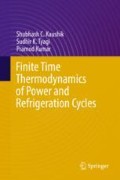Abstract
We know that heat engine is a power-producing device which absorbs heat from a high-temperature reservoir (heat source) and converts some of its part into mechanical (shaft) work and rejects the rest to a low-temperature reservoir (heat sink). All power-producing devices (heat engines) operate on cycles utilizing either gas or vapour, as the working fluid, and are known by their name. For example, if a heat engine utilizes gas as the working fluid, it is known as the gas power cycle such as Carnot, Brayton, Stirling, Ericsson, Braysson, etc. Similarly, if a heat engine utilizes vapour as the working fluid, it is known as the vapour power cycle such as Rankine cycle. The study and analysis of power cycles are very exciting and are an important part of the engineering thermodynamics, because they involve many complicated aspects and, hence, are very difficult to analyse completely. Some of these complicated aspects are pressure drop, friction, heat loss, entropy generations due to various causes, and the lack of sufficient time for the establishment of equilibrium condition, during each cycle, leading to more difficult, complex, and incomplete analysis of power cycles. To overcome these difficulties associated with power cycles, some idealistic assumptions are made. When a cycle is free from all irreversibilities and complexities, it is called an ideal cycle, and the processes followed by such cycle are reversible processes and vice versa. Most of the power cycles are designed for the purpose of converting thermal energy into shaft (mechanical) work. The performance of a heat engine is expressed in terms of thermal efficiency, which is basically the ratio of network produced by the heat engine to that of total heat supplied and denoted by η th, as below:
References
Curzon, F.L. and Ahlborn, B. (1975). Efficiency of a Carnot engine at maximum power output. American Journal of Physics, 43, 22–24.
Ibrahim, O.M., Klein, S.A. and Mitchell, J.W. (1991). Optimum heat power cycles for specified boundary conditions. J. Engg. Gas Turbines Power, 113, 514–521.
Kaushik, S.C. (1999). State-of-the-art on finite time thermodynamics. Internal Report CES, IIT Delhi, India.
Kaushik, S.C. and Tyagi, S.K. (2002). Finite time thermodynamic analysis of a nonisentropic regenerative Brayton heat engine. Int. J. Solar Energy, 22, 141–151.
Kumar, S. (2000). Finite time thermodynamic analysis and second law evaluation of thermal energy conversion systems. Ph.D. Thesis, C.C.S. University, Meerut India.
Tyagi, S.K., Kaushik, S.C. and Salhotra, R. (2002). Ecological optimization and parametric study of irreversible Ericsson and Stirling heat engines. Journal of Phys D: Appl. Phys, 35, 2668–2675.
Tyagi, S.K., Wang, S.W. and Park, S.R. (2008). Performance criteria on different pressure ratios of an irreversible modified complex Brayton cycle. Indian Journal of Pure & Applied Physics, 46, 565–574.
Wu, C. (1988). Power optimization of a finite time Carnot heat engine. Energy, 13(9), 681–687.
Wu, C. and Kiang, R.L. (1992). Finite time thermodynamic analysis of a Carnot engine with internal irreversibility. Energy, 17(12), 1173–1178.
Author information
Authors and Affiliations
Rights and permissions
Copyright information
© 2017 Capital Publishing Company, New Delhi, India
About this chapter
Cite this chapter
Kaushik, S.C., Tyagi, S.K., Kumar, P. (2017). Finite Time Thermodynamic Analysis of Carnot and Rankine Heat Engines. In: Finite Time Thermodynamics of Power and Refrigeration Cycles. Springer, Cham. https://doi.org/10.1007/978-3-319-62812-7_2
Download citation
DOI: https://doi.org/10.1007/978-3-319-62812-7_2
Published:
Publisher Name: Springer, Cham
Print ISBN: 978-3-319-62811-0
Online ISBN: 978-3-319-62812-7
eBook Packages: Physics and AstronomyPhysics and Astronomy (R0)

